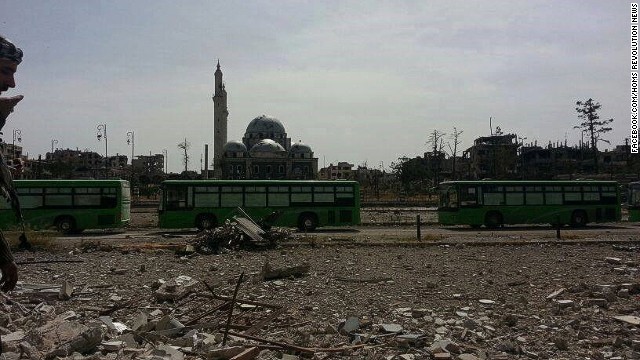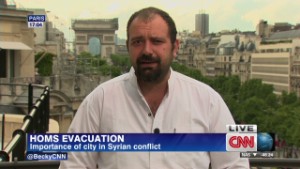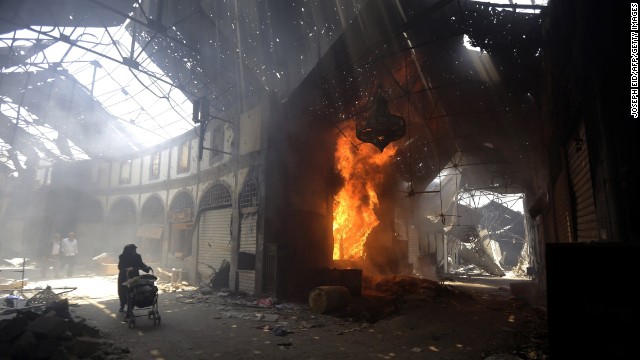What does the Homs truce mean for Syria?

Rebels begin evacuation of Homs
STORY HIGHLIGHTS
- Homs truce, and the evacuation of rebels, is significant
- Homs was, for a long time, the epicenter of the revolution
- This deal seems to have Russian and Iranian input
- It also shows negotiations can be fruitful
Editor's note: CNN
International Correspondent Fred Pleitgen has reported from inside Syria
numerous times during the conflict, last visiting Homs itself in June
2013. In this analysis, he explains what the truce means.
(CNN) -- A truce between Syrian government and rebel
forces in the strategic and symbolic city of Homs has gone into effect,
allowing the evacuation of opposition fighters and their families from
the Old City. The ancient city of Homs became known as the capital of
the uprising against the regime of Syrian President Bashar al-Assad.
It has experienced some
of the worst of the violence in a bloody civil war that has left more
than 100,000 people dead and driven millions of people from their homes
across the country.
How significant is the truce?
This is certainly a very
significant development on several levels. First, the regime has been
pushing to expel rebels from the central part of the country and the
area close to the Lebanese border. The battles for al-Qusair, the
Qalamoun Mountains with Yabroud and Maloula, and now Homs itself showed
how important the government feels this area is.
 Return to Homs
Return to Homs
 Photos: Syrian civil war in 2014
Photos: Syrian civil war in 2014
On the one hand it gives
the regime de facto control over a large and coherent chunk of the
country that stretches from Damascus up the highway to Homs and then all
the way to the Syrian coast with towns like Latakia and Tartous. With
that the regime has secured its route for logistics and also a possible
retreat should it become under pressure in Damascus.
For the rebels the truce
is significant for other reasons. Homs was one of the first places where
they were able to hold larger swaths of territory. The uprising in the
city began with grassroots demonstrations for democracy and only
defectors from the Syrian army took up arms there.
There were far fewer
Islamists in Homs than in many other places affected by the uprising
against al-Assad. So in many ways Homs was, for a long time, the
epicenter of the revolution and also the cradle of the Free Syrian Army.
In the end, however, the
rebels were encircled there and confined to the Old Town, the al-Waer
area, Talbiseh in the north of the city and a few other pockets. They
were besieged and could barely get supplies at all. The truce, if they
make it out safely, is probably the best outcome for them.
On a diplomatic front it
is also very important because it is a large scale truce that actually
seems to be working and both Russia and Iran appear to have been
involved in the process.
Furthermore, it is a
very complex deal that involves rebel fighters getting free passage in
return for the release of pro-regime prisoners in a totally different
part of the country (the Aleppo area), as well as aid being allowed into
besieged pro-Assad areas also in Syria's north, the Syrian Observatory
for Human Rights says.
It shows that
larger-scale negotiations can be fruitful if all sides want solutions,
even in light of the diplomatic failures in the past and the fractured
state of the opposition.
Is this the first time that a truce has ever been brokered in the Syria conflict?
It is certainly the
largest regional truce that has ever been brokered and gone into effect,
but it is not the first. As early as 2013 pro-government politicians
and rebel commanders were brokering local cease-fires in Homs province.
We visited the town of Tal Kalakh on the border with Lebanon in March
2013, which at the time was held by the opposition, but encircled by
al-Assad's forces.
Regional leaders had brokered a truce between the two sides though that allowed at least some semblance of public life to return to the area.
On the whole, I believe
these cease-fires show that in many places, the Syrian population is far
ahead of the politicians, rebels and the military that claim to
represent them. Many want the fighting to stop and they certainly do not
want Syrians to continue killing other Syrians. But that does not mean
that an end to the conflict is in any way near.
What does this mean for the broader Syrian conflict?
The conflict is nowhere
near a solution. The fighting is worse than ever in Aleppo, where the
Syrian army continues to use weapons like barrel bombs and other heavy
ordinance and the rebels are also pushing to win ground, also using
artillery and the like. No side is willing to back down at this point.
Bashar al-Assad seems to feel that the momentum is on his side and said
exactly that in a recent interview. The regime feels it is a fairly
comfortable position and is also pounding the rebels in the outskirts of
Damascus.
Meanwhile the rebels are
still divided, but also making gains in certain areas. A much
overlooked place is the south of the country around Deraa, where the
opposition has been making inroads near the important highway to
Damascus. The anti-Assad groups in the south of the country appear to be
the most disciplined and politically and religiously moderate of all.
They are also getting
regular supplies of weapons via the border with Jordan. In the north of
the country, the picture is patchier. The advent of the Islamic Front as
a new fighting force has certainly done much to consolidate the
opposition there.
Right now the main
players are Islamic Front, the al Qaeda-linked Nusra Front and the most
radical group, the al Qaeda-affiliated Islamic State of Iraq and Greater
Syria (ISIS), which is at war with most of the other rebel groups.
There still is a lot of
rebel infighting, but the Islamic Front and Nusra have recently made
gains in the Aleppo area and also in Latakia province, the ancestral
homeland of Bashar al-Assad.
Does this show that Bashar al-Assad is winning?
Bashar al-Assad is
winning in certain places but losing ground in others. He is making
gains around Damascus and in Homs and its outlying areas. There is a
bloody stalemate in the Aleppo area. The rebels are making gains in the
northwest in Latakia province and also in the south.
What appears to be going
on is that al-Assad is carving out a heartland that stretches from the
capital Damascus via Homs to the Mediterranean Sea, encompassing Latakia
and Tartous to give him access to ports. The main focus of the Syrian
military in the past year has been the battle for Damascus, for the
Damascus to Homs highway and Homs itself.
But al-Assad is not even
close to winning the civil war. No one is. If anything, the current
situation seems to show that there cannot be a military solution to this
conflict.
We have heard so much about the destruction in Homs, what is it really like there?
Homs is a tragedy. The
first traces of civilization there go back to around 2000 BC and now
much of it is being destroyed. We were able to visit the Baba Amr
district which was one of the places that the opposition held, but which
the government won back in 2012.
The scene there is
tragic. We were not able to find a single building that was not totally
destroyed. People were slowly starting to come back, but it does not
seem like life is possible there at the moment. The same was also true,
until now, of the old town. The closer you got to the front line, the
more destruction you would see.
The fighting that was
going on there in the end was typical urban warfare with government
soldiers and rebels fighting for every house, punching holes through
walls for safe access and command centers set up in destroyed
apartments. Until recently you could hear gunfire in Homs almost around
the clock.
The bizarre thing about
that situation was that just a block or two further down the road you
would never have known that there had been fighting. All the building
were intact, there were people on the streets in cafes and kebab shops
and the shops were well stocked.
In many cases it seems
that people were making an extra effort to give their lives some
normalcy, but of course all of them have been touched by the conflict in
some way.
May 7, 2014 -- Updated 2241 GMT (0641 HKT)
we pray everything is possible to GOD ALLMIGHTY.
ReplyDelete